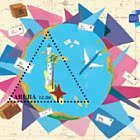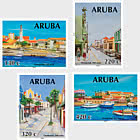500c - Coat of Arms
Understanding our Weapon
A Coat of Arms is a symbol of union and entity, both locally and internationally
The aloe plant
The aloe plant represents the first source of wealth and industry of our country.
The Hooiberg
The Hooiberg symbolizes our island rising out of the sea.
The green color is the color of joy that we have experienced since our autonomy.
The wavelike lines symbolize our sea.
Two shaking hands
Two shaking hands stand for the good relations of Aruba with the rest of the world, in political, economic and cultural areas.
The red color symbolizes our generous nature, our simplicity and work value to strengthen these relations.
The gear-wheel
The gear-wheel symbolizes the helm indicating the right turn to the industry, which is the main life source of our island.
The cross
The white cross serves to divide the shield into four quarters and symbolizes devotion and faith.
The lion
On top of the Shield there is a lion in red that stands for power, generosity and the bond with the Kingdom of the Netherlands.
The laurel branches
Below the Shield laurel branches are depicted, which are traditional symbols of peace, joy and friendship.
500c - Flag
Since 1955 the island has had an official Coat of Arms and a song that most people regarded as the National Anthem of Aruba, but we still lacked a Flag.
On January 21, 1976, preparations began, through public participation in a contest, to design the Flag. A total of 693 designs were received. Most participants were schoolchildren. Their wish was to see a star with four points, and for several reasons. There was also a preference for colored stripes or signs, both in horizontal and in vertical direction.
Since the Flag of Aruba officially came into existence on March 18, 1976, along with the official Anthem ‘Aruba Dushi Tera’, and since Aruba on January 1, 1986, received the ‘Status Aparte’, which is the position of an autonomous country within the Kingdom of the Netherlands, the Flag of the country Aruba along with the National Anthem and the Coat of Arms was embedded in the law on October 17, 1991 (AB 1991 no. 101), ( effective AB 1991 no. 118) and includes the official colors of yellow, blue, white and red. This law has since then been valid for and applicable to the official Flag of Aruba.
The color blue represents the immense sea that surrounds Aruba. Yellow is the color of abundance and the horizontal lines represent the solidity of same.
Yellow represents the current industry and tourism as its main sources of income and the gold- and aloe industry from the industrial past. Yellow also stands for the trees and plants of Aruba that bloom yellow such as the 'kibrahacha’, ‘brazil’, ‘bonchi di strena', 'curahao', 'tuturutu' and 'wanglo’.
The color red represents the four points of a compass and symbolizes the origin of the people from all wings of heaven. It also represents the old industry of Brazil wood and it is a tribute to the blood of the Indians that was shed in 'Rooi Frances’ for the freedom of Aruba.
The color white that borders the red star symbolizes the beautiful white beaches and the purity of the Aruban people.
500c - National Anthem
The National Anthem of Aruba is called ‘Aruba Dushi Tera’. The history of the song that became our National Anthem dates back from 1951.
Two well-known musicians, the late Rufo Wever and Juan Chabaya ‘Padu’ Lampe, have composed this song and they have taken the typical rhythm and melody of Aruba on a record.
They have different numbers put on the record and ensured that many compositions should not be lost from that period.
Until now we consider them, two highly respected people of our Aruban music. Most people still love to listen to their music.
In 1952, these musicians have composed our National Anthem. They have felt the need to compose a song expressing the love of the people for our island in order to arouse the feeling of homeland of everyone.
The musical and singing group ‘The Trupialen’, led by Frère Alexius, has included this song in their repertoire, which became increasingly popular.
The popularity of the song was even bigger in 1954 when at the instigation of Frère Alexius, the song on a 78rpm vinyl record was recorded by Radio Kelkboom, sung by ‘The Trupialen’ and on piano by Padu Lampe.
In a very spontaneous manner began other private entities to use this song on special occasions. In the 70s of last century, the Government appointed a committee set up consisting of Maybeline Arends-Croes, Rufo Odor, Padu Lampe, the late Eddy Bennett, the late Hubert 'Lio' Booi and the late Rufo Wever.
The committee made a recommendation unanimously on February 25, 1976 for ‘Aruba Dushi Tera 'as Anthem in the rhythm of waltz.
Hubert 'Lio' Booi, with his inspiration to the final verse added the sentence: ‘... may God guide her (Aruba) and retained her love for freedom.’ With this phrase he has praised the cordiality of the Aruban people and her love for freedom.
On March 16, 1976, the Island of Aruba, adopted the 'Aruba Dushi Tera' as the official Anthem of Aruba. On March 18, 1976, during an official ceremony at the Wilhelmina Stadium (now Stadion Guillermo Prospero Trinidad), the 'Aruba Dushi Tera' was declared the National Anthem.
The National Anthem was produced by a choir led by Maybeline Arends-Croes with accompaniment of the Philharmonic Orchestra of Aruba under the leadership of Joy Kock.






































